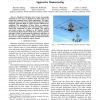Free Online Productivity Tools
i2Speak
i2Symbol
i2OCR
iTex2Img
iWeb2Print
iWeb2Shot
i2Type
iPdf2Split
iPdf2Merge
i2Bopomofo
i2Arabic
i2Style
i2Image
i2PDF
iLatex2Rtf
Sci2ools
113
Voted
ICRA
2009
IEEE
2009
IEEE
Aerodynamics and control of autonomous quadrotor helicopters in aggressive maneuvering
Quadrotor helicopters have become increasingly important in recent years as platforms for both research and commercial unmanned aerial vehicle applications. This paper extends previous work on several important aerodynamic effects impacting quadrotor flight in regimes beyond nominal hover conditions. The implications of these effects on quadrotor performance are investigated and control techniques are presented that compensate for them accordingly. The analysis and control systems are validated on the Stanford Testbed of Autonomous Rotorcraft for Multi-Agent Control quadrotor helicopter testbed by performing the quadrotor equivalent of the stall turn aerobatic maneuver. Flight results demonstrate the accuracy of the aerodynamic models and improved control performance with the proposed control schemes.
ICRA 2009 | Important Aerodynamic Effects | Quadrotor Helicopter | Robotics | Unmanned Aerial Vehicle |
| Added | 19 Feb 2011 |
| Updated | 19 Feb 2011 |
| Type | Journal |
| Year | 2009 |
| Where | ICRA |
| Authors | Haomiao Huang, Gabriel Hoffmann, Steven Lake Waslander, Claire J. Tomlin |
Comments (0)

